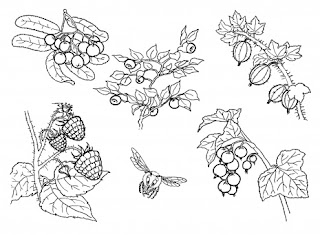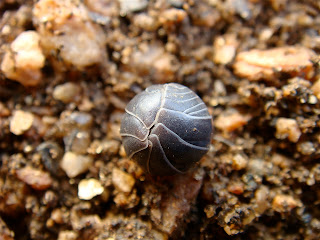August 29th, 2011
Welcome song
Letter of the Day- B. For berries, birds, beautiful, bee, buzz,
Today we are going to be learning about berries and pollination.
Pollination
Who remembers this word- Pollination?
What is pollination? Pollination is what happens when a flower turns into a seed, or a berry, or a fruit. The flower is beautiful and attractive and smells wonderful. Little insects come and get nectar from the flower. When they land on the flower, they get a little bit of pollen on them. Then they spread that pollen to the next flower they go to. That is exactly what the flower wants to have happen!!! Spreading pollen from one flower to the next is great!! Then the seed begins to grow.
We, humans, love to eat the seeds, berries, or fruit that come from the flowers of plants after they are pollinated. Do you want to see some seeds of some plants we eat? Can you guess what plant they come from?
Senses Walk
Use a bandana or scarf to blindfold your budding naturalists and then carefully guide them through the park on a hike. Encourage them to use their other senses to experience the trip. Guide them towards trees and have them touch the bark, leaves and branches. What do they feel like? Have them stand still and listen. What sounds can they identify? What do they smell? Now switch places and let your child guide you!
Nature Scavenger Hunt
Hand out papers and pens
Nature collection and berry picking
We are going to pick some berries while on our hike today. With those berries, we will make a special ink that pioneers used long ago. Blackberry juice was used to dye cloth navy blue and indigo.
So, i want you to collect some different things in your bag. Berries, of course! I also want you to look for natural materials that you can use as a paintbrush- leaves, grass, sticks, stems, dandelions and other flowers, evergreen twigs, etc. Be creative! Put them in your bag and we will use them when we are done with our hike.
Pioneer Craft:
Homemade Ink from Berries
True ink could be very expensive so many pioneers had to make their own. Inks were made at home from many different ingredients depending on what color was needed or wanted.
According to different sources, they used berries, powdered roots, nuts, and even chimney soot.
Ingredients:
1/2 cup of ripe berries (blueberries, cherries, blackberries, strawberries, elderberries, raspberries, etc.
1/2 teaspoon vinegar
1/2 teaspoon salt
Tools:
measuring cups and spoon
strainer
bowl
wooden spoon
Directions:
1. Fill the strainer with the berries and hold it over a bowl.
2. Using the rounded back of a wooden spoon, crush the berries against the strainer so that the berry juice strains into the bowl.
3. Keep adding berries until most of their juice has been strained out and only pulp remains.
4. Add the salt and vinegar to the berry juice. The vinegar helps the ink to retain its color and the salt keeps it from getting moldy.
5. If the berry ink is too thick, a tablespoon of water.
Craft:
Use the ink and the natural paintbrushes the children collected to paint a picture. Let the children incorporate natural materials into their picture using glue and scissors.





